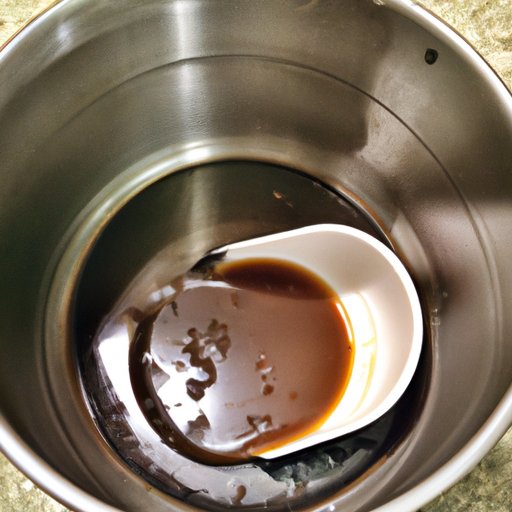Introduction
Cooking grease is the fat or oil that accumulates during the cooking process. It can come from frying, baking, roasting, or sautéing meats, vegetables, and other foods. Grease can also be found in sauces, gravies, and dressings. Knowing what to do with cooking grease is important for both safety and environmental reasons.
How to Safely Dispose of Cooking Grease
The most important thing to remember when disposing of cooking grease is to never pour it down the sink or toilet. This can cause clogs and blockages in your plumbing system, as well as damage septic tanks or wastewater treatment systems. The best way to dispose of cooking grease is to put it in a sealed container and discard it in the garbage. If you are unsure of the best way to dispose of cooking grease in your area, contact your local waste management company for further advice.
5 Creative Ways to Reuse Cooking Grease
Cooking grease can be reused in a variety of ways. Here are some of the most popular:
- Frying eggs or vegetables
- Using as a spread on toast or sandwiches
- Using as a base for gravy or sauces
- Adding to soups and stews
- Using as a lubricant

3 Tips for Storing Cooking Grease for Later Use
If you choose to store cooking grease for later use, here are three tips to ensure its safety:
- Store in airtight containers
- Label containers with date and type of grease
- Store in refrigerator or freezer for longer shelf life

4 Recipes That Utilize Cooking Grease
Cooking grease adds flavor and texture to many dishes. Here are four recipes that make use of cooking grease:
- Fried Rice: Heat cooking grease in a wok or large skillet over medium heat. Add cooked rice and stir-fry until lightly browned. Add vegetables and seasonings of your choice and continue to stir-fry until vegetables are tender. Serve hot.
- Biscuits: Preheat oven to 425 degrees Fahrenheit. In a large bowl, mix 2 cups of flour, 1 tablespoon of baking powder, ½ teaspoon of salt, and ¼ cup of cooking grease. Gradually add ¾ cup of milk, stirring until a soft dough forms. Turn out onto a floured surface and knead lightly. Roll out the dough to ½ inch thickness and cut into circles. Place on an ungreased baking sheet and bake for 12-15 minutes, or until golden brown.
- Sautéed Vegetables: Heat cooking grease in a large skillet over medium-high heat. Add your favorite vegetables (such as onions, peppers, mushrooms, etc.) and stir-fry until just tender. Season with salt and pepper to taste. Serve hot.
- Pan-Fried Fish: Heat cooking grease in a large skillet over medium-high heat. Season fish fillets with salt and pepper. Place in skillet and cook for 3-4 minutes per side, or until fish is cooked through. Serve hot.

Benefits of Cooking with Grease vs. Oil
Cooking with grease has several advantages over cooking with oil. Firstly, it has a higher smoke point than oil, which means it can be heated to higher temperatures before smoking and burning. Secondly, grease has a more intense flavor than oil, so it can add more flavor to dishes. Finally, grease is easier to clean up than oil, as it does not splatter as much when heated.
Conclusion
Cooking grease is an essential part of many recipes and can also be used in various creative ways. Before disposing of cooking grease, always remember to never pour it down the sink or toilet. Instead, store it in a sealed container and discard in the trash. Reusing cooking grease is also a great way to get the most out of the ingredient. There are numerous recipes that utilize cooking grease, plus it has several benefits over oil. Experiment with different types of cooking grease and find out which ones work best for you! For more information on cooking with grease, visit your local library or search online.


